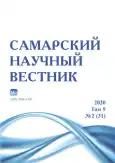Колониальный опыт межкультурного взаимодействия на примере индейских войн XVII века
- Авторы: Нестеров Д.А.1
-
Учреждения:
- Самарский государственный социально-педагогический университет
- Выпуск: Том 9, № 2 (2020)
- Страницы: 168-171
- Раздел: Исторические науки и археология
- URL: https://journals.rcsi.science/2309-4370/article/view/41951
- DOI: https://doi.org/10.17816/snv202204
- ID: 41951
Цитировать
Полный текст
Аннотация
В данной статье рассматриваются европейские и индейские ответы на межкультурные убийства в колониальной Америке в XVII веке. Определяются основные отличия между правовыми традициями европейских поселенцев и американских аборигенов. Главными из них было отсутствие у индейских племен институционализированных структур и наличие коллективной ответственности за совершенное преступление, когда наказание за преступление нес весь клан преступника. В рассматриваемый нами исторический период многие индейские племена пытаются заменить принцип кровной мести возместительной платой различными товарами, арбитражем со стороны сахема, «церемониями соболезнования» и тому подобным. Основной проблемой ответов на межкультурные убийства стало нежелание сторон договариваться об одной общей юрисдикции. В связи с этим любое убийство с участием как индейца, так и европейца имело возможность превратиться в массовый конфликт или даже войну. Первым подобным случаем стало убийство английского капитана Джона Стоуна, послужившее поводом к началу Пекотской войны. Вторым случаем стало убийство индейца-христианина Джона Сассамона. В этом деле колонисты впервые заявили, что имеют право судить и осуждать индейцев в соответствии с английскими стандартами правосудия. Все это привело непосредственно к конфликту, известному как война короля Филиппа. Данные межкультурные убийства стали одним из способов по расширению территорий европейских колоний и укреплению власти поселенцев в регионе.
Ключевые слова
Полный текст
Открыть статью на сайте журналаОб авторах
Дмитрий Александрович Нестеров
Самарский государственный социально-педагогический университет
Автор, ответственный за переписку.
Email: dmitriynesterov1994@gmail.com
аспирант, ассистент кафедры всеобщей истории, права и методики обучения
Россия, СамараСписок литературы
- Field Manual, Marine Corps Warfighting Publication 3–33.5. Counterinsurgency [US Army FM 3–24]. United States Army Headquarters and United States Marine Corps Combat Development Command. Washington, DC, 15 December 2006.
- McFate M. Does culture matter // The military utility of understanding adversary culture. Retrieved November. 2007. Vol. 15. P. 1–22.
- Hoffman F.G. Neo-classical counterinsurgency? // Parameters. 2007. Vol. 37, № 2. P. 71–87.
- Dixon P. ‘Hearts and minds’? British counter-insurgency from Malaya to Iraq // Journal of Strategic Studies. 2009. Vol. 32, № 3. P. 353–381.
- Smith S. General Templer and counter-insurgency in Malaya: Hearts and minds, intelligence, and propaganda // Intelligence and National Security. 2001. Vol. 16, № 3. P. 60–78.
- US Marine Corps, Small Wars Manual. Washington: United States Government Printing Office, 1935 [1940].
- Banner S. The death penalty: an American history. Cambridge, Mass.: Harvard University Press, 2003. 408 p.
- Kawashima Y. Igniting King Philip’s War. Lawrence, Kans.: University of Kansas Press, 2001. 192 p.
- Reid J.-Ph. A law of blood: the primitive law of the Cherokee nation. DeKalb, Ill.: Northern Illinois University Press, 2006. 348 p.
- Jennings F. The invasion of America: Indians, colonialism, and the cant of conquest. New York: Norton, 1976. 392 p.
- Lepore J. In the name of War: King Philip’s war and the origins of American identity. New York: Vintage Books, 1998. 368 p.
- Stannard D.E. American holocaust: Columbus and the conquest of the New World. New York and Oxford: Oxford University Press, 1992. 416 p.
- Churchill W. A little matter of genocide: holocaust and denial in the Americas, 1492 to the present. San Francisco: City Lights Books, 1997. 531 p.
- Reid J.-Ph. Principles of Vengeance: fur trappers, Indians, and retaliation for homicide in the transboundary north American west // Western Historical Quarterly. 1993. Vol. 24, № 1. P. 21–44.
- White R. The middle ground: Indians, empires, and republics in the Great Lakes region, 1650–1815. New York, N.Y.: Cambridge University Press, 1991. 576 p.
- Oberg M.L. Uncas: first of the Mohegans. Ithaca, N.Y.: Cornell University Press, 2003. 288 p.
- Richter D.K. The Ordeal of the longhouse: the peoples of the Iroquois league in the ear of European colonization. Chapel Hill, N.C.: University of North Carolina Press for the Institute of Early American History and Culture, 1992. 454 p.
- Haefeli Е. Kieft’s War and the Systems of Violence in Colonial America // Lethal imagination: violence and brutality in American history / ed. M.A. Bellesiles. New York, N.Y.: New York University Press, 1999. P. 17–40.
- Cave А. Who killed John Stone? A note on the origins of the Pequot war // William and Mary Quarterly. 3rd series. 1992. Vol. 49, № 3. P. 509–521.
- Oberg M.L. Dominion and civility: English imperialism and Native America, 1585–1685. Ithaca, N.Y: Cornell University Press, 1999. 256 p.
- Hubbard W. A narrative of the Indian Wars in New England. Stockbridge, MA: Willard, 1803. 394 p.
- Lepore J. Dead men tell no tales: John Sassamon and the fatal consequences of literacy // American Quarterly. 1994. Vol. 26, № 4. P. 479–512.
- James P., Ronda J. The death of John Sassamon: an exploration in writing new England Indian history // American Indian Quarterly. 1974. Vol. 1, № 2. P. 91–102.
- Mandell D.R. King Philip's War: colonial expansion, native resistance, and the end of Indian sovereignty. Baltimore: Johns Hopkins University Press, 2010. 176 p.
Дополнительные файлы






